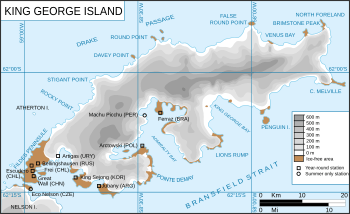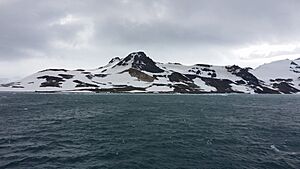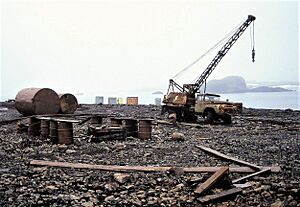King George Island (South Shetland Islands) facts for kids

Map of King George Island, Antarctica
|
|
|
Location in the South Shetland Islands##Location in Antarctica
|
|
| Geography | |
|---|---|
| Location | Antarctica |
| Coordinates | 62°02′S 58°21′W / 62.033°S 58.350°W |
| Archipelago | South Shetland Islands |
| Area | 1,150 km2 (440 sq mi) |
| Length | 95 km (59 mi) |
| Width | 25 km (15.5 mi) |
| Administration | |
| Administered under the Antarctic Treaty System | |
| Demographics | |
| Population | around 500 |
King George Island is the largest island in the South Shetland Islands. It is located about 120 kilometers (75 miles) off the coast of Antarctica in the Southern Ocean. This island was named after King George III of Great Britain. Other names for the island include Isla 25 de Mayo (Argentina) and Isla Rey Jorge (Chile).
Contents
Geography of King George Island
King George Island has three main bays: Maxwell Bay, Admiralty Bay, and King George Bay. Admiralty Bay is special because it has three fjords. It is also a protected area under an international agreement. This means its environment is carefully managed.
The island is about 95 kilometers (59 miles) long and 25 kilometers (16 miles) wide. Its total land area is 1,150 square kilometers (440 square miles). More than 90% of the island is covered by permanent glaciers (large sheets of ice).
History of King George Island
A British explorer named William Smith discovered King George Island in 1819. He named it after the king at that time, George III.
The United Kingdom claimed the island in 1819. It later became part of the British Antarctic Territory. Chile also claimed the island in 1940, calling it part of the Chilean Antarctic Territory. In 1943, Argentina claimed it as part of Argentine Antarctica, naming it Isla Veinticinco de Mayo. This name honors Argentina's National Day.
The United States and Russia do not recognize these claims. They have kept their right to claim land in Antarctica in the future.
In 1821, eleven men from a sealing ship called Lord Melville spent the winter on the island. They were the first people to survive a winter in Antarctica.
Wildlife on King George Island
The coastal areas of King George Island are home to many different plants and animals. You can find elephant seals, Weddell seals, and leopard seals here.
The island is also a nesting place for several types of penguins, including Adelie, chinstrap, and gentoo penguins. Other seabirds like skuas and southern giant petrel also nest on the island during the summer.
Human Activities and Research
Many countries have research stations on King George Island. These include Argentina, Brazil, Chile, China, South Korea, Peru, Poland, Russia, Uruguay, and the United States. Most of these stations are open all year. Scientists there study many things, like biology (living things), ecology (how living things interact with their environment), geology (rocks and Earth's structure), and palaeontology (fossils).
The Chilean station, Base Presidente Eduardo Frei Montalva, is like a small village. It has an airstrip, cafeterias, a bank, a post office, and homes for families with children. Even though Chile claims this land, the Antarctic Treaty allows them to have a station there without pushing their claim too much. The Chinese Great Wall base even has an indoor basketball court!
In 2004, a Russian Orthodox church called Trinity Church was built near Russia's Bellingshausen Station. It is one of the southernmost churches in the world and has a priest living there permanently.
In 2013, the famous heavy metal band Metallica performed a concert on the island.
Some special tourist activities happen in the summer. One popular event is the annual Antarctic marathon.
Point Thomas lighthouse at Arctowski Station is known as the most southerly lighthouse in the world.
The NOAA runs Lenie Base, a research station that studies penguins. This small station is used only in the Antarctic summer.
Climate of King George Island
King George Island and the nearby Antarctic Peninsula have some of the mildest weather in Antarctica. The ocean around the island greatly affects its climate. It is one of the few places in Antarctica that has a tundra climate instead of an ice cap climate. This means it's cold, but not always covered in thick ice sheets.
Temperatures do not change much throughout the year. The coldest month, July, averages about -6.5°C (20.3°F). The warmest month, January, averages about 1.5°C (34.7°F). The weather is often cloudy, with snow, rain, and drizzle happening frequently. The island receives about 729 millimeters (28.7 inches) of precipitation each year. It also gets about 591 hours of sunshine per year, which is not very much.
Images for kids
See also
 In Spanish: Isla Rey Jorge para niños
In Spanish: Isla Rey Jorge para niños






